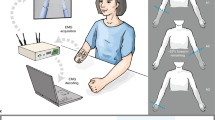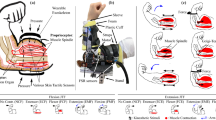Abstract
We used proportional myoelectric control of a one-dimensional virtual object to investigate differences in efferent control between the proximal and distal muscles of the upper limbs. Eleven subjects placed one of their upper limbs in a brace that restricted movement while we recorded electromyography (EMG) signals from elbow flexors/extensors or wrist flexors/extensors during isometric contractions. By activating their muscles, subjects applied virtual forces to a virtual object using a real-time computer interface. The magnitudes of these forces were proportional to EMG amplitudes. Subjects used this proportional EMG control to move the virtual object through two tracking tasks, one with a static target and one with a moving target (i.e., a sine wave). We hypothesized that subjects would have better control over the virtual object using their distal muscles rather than using their proximal muscles because humans typically use more distal joints to perform fine motor tasks. The results indicated that there was no difference in subjects’ ability to control virtual object movements when using either upper arm muscles or forearm muscles. These results suggest that differences in control accuracy between elbow joint movements and wrist joint movements are more likely to be a result of motor practice, proprioceptive feedback or joint mechanics rather than inherent differences in efferent control.








Similar content being viewed by others
References
Basmajian JV, Blumenstein R (1989) Electrode placement in electromyographic biofeedback. In: Basmajian JV (ed) Biofeedback: principles and practice for clinicians. Williams and Wilkins, Baltimore, pp 369–382
Bizzi E, Tresch MC, Saltiel P, d’Avella A (2000) New perspectives on spinal motor systems. Nat Rev Neurosci 1:101–108
Crago PE, Houk JC, Rymer WZ (1982) Sampling of total muscle force by tendon organs. J Neurophysiol 47:1069–1083
De Domenico G, McCloskey DI (1987) Accuracy of voluntary movements at the thumb and elbow joints. Exp Brain Res 65:471–478
Dettmers C, Connelly A, Stephan KM, Turner R, Friston KJ, Frackowiak RS, Gadian DG (1996a) Quantitative comparison of functional magnetic resonance imaging with positron emission tomography using a force-related paradigm. Neuroimage 4:201–209
Dettmers C, Lemon RN, Stephan KM, Fink GR, Frackowiak RS (1996b) Cerebral activation during the exertion of sustained static force in man. Neuroreport 7:2103–2110
Dupont AC, Morin EL (1994) A myoelectric control evaluation and trainer system. IEEE Trans Rehabil Eng 2:100–107
Evans HB, Pan Z, Parker PA, Scott RN (1984) Signal processing for proportional myoelectric control. IEEE Trans Biomed Eng 31:207–211
Gaine WJ, Smart C, Bransby-Zachary M (1997) Upper limb traumatic amputees. Review of prosthetic use. J Hand Surg [Br] 22:73–76
Gaines BR (1969) Linear and nonlinear models of human controller. Int J Man-Machine Studies 1:333–360
Gallant PJ, Morin EL, Peppard LE (1998) Feature-based classification of myoelectric signals using artificial neural networks. Med Biol Eng Comput 36:485–489
Gandevia SC, Kilbreath SL (1990) Accuracy of weight estimation for weights lifted by proximal and distal muscles of the human upper limb. Journal of Physiology (London) 423:299–310
Gandevia SC, McCloskey DI, Burke D (1992) Kinaesthetic signals and muscle contraction. Trends Neurosci 15:62–65
Georgopoulos AP, Pellizzer G, Poliakov AV, Schieber MH (1999) Neural coding of finger and wrist movements. J Comput Neurosci 6:279–288
Goodwin GM, McCloskey DI, Matthews PB (1972) Proprioceptive illusions induced by muscle vibration: contribution by muscle spindles to perception? Science 175:1382–1384
Gottlieb GL (1996) Muscle compliance: implications for the control of movement. Exerc Sport Sci Rev 24:1-34
Gregory JE, Proske U (1979) The responses of Golgi tendon organs to stimulation of different combinations of motor units. J Physiol 295:251–262
Hall LA, McCloskey DI (1983) Detections of movements imposed on finger, elbow and shoulder joints. J Physiol 335:519–533
Hogan N (1976) A review of the methods of processing EMG for use as a proportional control signal. Biomed Eng 11:81–86
Hogan N (1985) The mechanics of multi-joint posture and movement control. Biol Cybern 52:315–331
Hudgins B, Parker P, Scott RN (1993) A new strategy for multifunction myoelectric control. IEEE Trans Biomed Eng 40:82–94
Jami L (1992) Golgi tendon organs in mammalian skeletal muscle: functional properties and central actions. Physiol Rev 72:623–666
Jones KE, Wessberg J, Vallbo AB (2001) Directional tuning of human forearm muscle afferents during voluntary wrist movements. J Physiol 536:635–647
Jones LA (2000) Visual and haptic feedback in the control of force. Exp Brain Res 130:269–272
Kearney RE, Stein RB, Parameswaran L (1997) Identification of intrinsic and reflex contributions to human ankle stiffness dynamics. IEEE Trans Biomed Eng 44:493–504
Kirsch RF, Stein RB (1997) Neural and muscular properties: current views and controversies. In: Winters JM, Crago PE (eds) Biomechanics and neural control of movement. Springer, New York Berlin Heidelberg
Lovely DF, Stocker D, Scott RN (1990) A computer-aided myoelectric training system for young upper limb amputees. J Microcomput Appl 13:245–259
Lundberg A, Malmgren K, Schomburg ED (1978) Role of joint afferents in motor control exemplified by effects on reflex pathways from Ib afferents. J Physiol 284:327–343
Macefield G, Gandevia SC, Burke D (1990) Perceptual responses to microstimulation of single afferents innervating joints, muscles and skin of the human hand. J Physiol 429:113–129
Manal K, Gonzalez RV, Lloyd DG, Buchanan TS (2002) A real-time EMG-driven virtual arm. Comput Biol Med 32:25–36
Millstein SG, Heger H, Hunter GA (1986) Prosthetic use in adult upper limb amputees: a comparison of the body powered and electrically powered prostheses. Prosthet Orthot Int 10:27–34
Mirbagheri MM, Barbeau H, Kearney RE (2000) Intrinsic and reflex contributions to human ankle stiffness: variation with activation level and position. Exp Brain Res 135:423–436
Moberg E (1983) The role of cutaneous afferents in position sense, kinaesthesia, and motor function of the hand. Brain 106:1–19
Moran DW, Schwartz AB (1999) Motor cortical representation of speed and direction during reaching. J Neurophysiol 82:2676–2692
Morin E, Parker PA, Scott RN (1993) Operator error in a level coded myoelectric control channel. IEEE Trans Biomed Eng 40:558–562
Mussa-Ivaldi FA, Hogan N, Bizzi E (1985) Neural, mechanical, and geometric factors subserving arm posture in humans. J Neurosci 5:2732–2743
Ng JK-F, Richardson CA, Kippers V, Parnianpour M, Bui BH (1996) Clinical applications of power spectral analysis of electromyographic investigations in muscle function. Man Ther 2:99–103
Nirkko AC, Ozdoba C, Redmond SM, Burki M, Schroth G, Hess CW, Wiesendanger M (2001) Different ipsilateral representations for distal and proximal movements in the sensorimotor cortex: activation and deactivation patterns. Neuroimage 13:825–835
Paciga JE, Richard PD, Scott RN (1980) Error rate in five-state myoelectric control systems. Med Biol Eng Comput 18:287–290
Prochazka A, Wand P (1980) Tendon organ discharge during voluntary movements in cats. J Physiol 303:385–390
Rao AK, Gordon AM (2001) Contribution of tactile information to accuracy in pointing movements. Exp Brain Res 138:438–445
Reina GA, Moran DW, Schwartz AB (2001) On the relationship between joint angular velocity and motor cortical discharge during reaching. J Neurophysiol 85:2576–2589
Roeschlein RA, Domholdt E (1989) Factors related to successful upper extremity prosthetic use. Prosthet Orthot Int 13:14–18
Schwartz AB, Moran DW (2000) Arm trajectory and representation of movement processing in motor cortical activity. Eur J Neurosci 12:1851–1856
Scott RN (1966) Myoelectric control of prostheses. Arch Phys Med Rehabil 47:174–181
Scott RN, Parker PA (1988) Myoelectric prostheses: state of the art. J Med Eng Technol 12:143–151
Scott RN, Paciga JE, Parker PA (1978) Operator error in multistate myoelectric control systems. Med Biol Eng Comput 16:296–301
Sears HH, Shaperman J (1991) Proportional myoelectric hand control: an evaluation. Am J Phys Med Rehabil 70:20–28
Stein RB, Zehr EP, Lebiedowska MK, Popovic DB, Scheiner A, Chizeck HJ (1996) Estimating mechanical parameters of leg segments in individuals with and without physical disabilities. IEEE Trans Rehabil Eng 4:201–211
Taira M, Boline J, Smyrnis N, Georgopoulos AP, Ashe J (1996) On the relations between single cell activity in the motor cortex and the direction and magnitude of three-dimensional static isometric force. Exp Brain Res 109:367–376
Thickbroom GW, Phillips BA, Morris I, Byrnes ML, Mastaglia FL (1998) Isometric force-related activity in sensorimotor cortex measured with functional MRI. Exp Brain Res 121:59–64
Viitasalo JH, Komi PV (1977) Signal characteristics of EMG during fatigue. Eur J Appl Physiol Occup Physiol 37:111–121
Zecca M, Micera S, Carrozza MC, Dario P (2002) Control of multifunctional prosthetic hands by processing the electromyographic signal. Crit Rev Biomed Eng 30:459–485
Acknowledgements
The authors would like to thank the members of the University of Michigan Human Neuromechanics Laboratory for their insights and contributions to this project. Supported by NIH R01NS045486.
Author information
Authors and Affiliations
Corresponding author
Rights and permissions
About this article
Cite this article
Gordon, K.E., Ferris, D.P. Proportional myoelectric control of a virtual object to investigate human efferent control. Exp Brain Res 159, 478–486 (2004). https://doi.org/10.1007/s00221-004-1970-6
Received:
Accepted:
Published:
Issue Date:
DOI: https://doi.org/10.1007/s00221-004-1970-6




